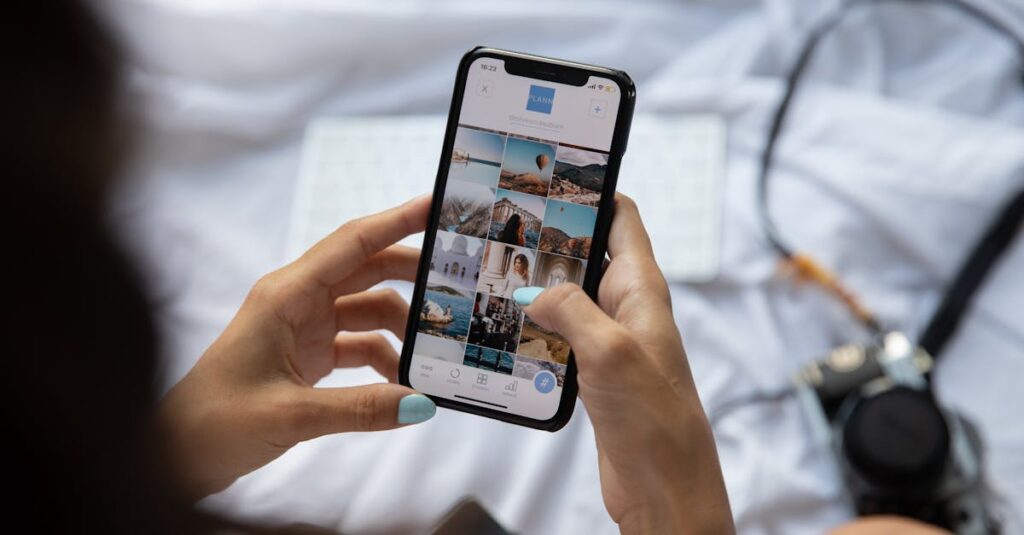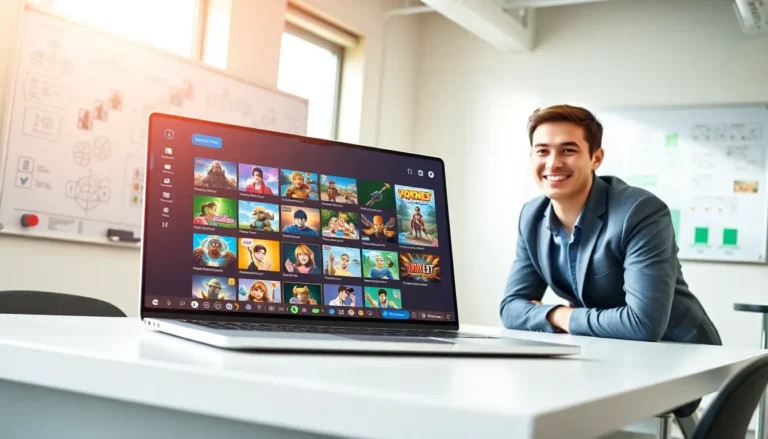Table of Contents
ToggleIn a world where everyone’s glued to their smartphones, the design of a mobile app can make or break its success. Imagine scrolling through an app that feels like a breath of fresh air—smooth, intuitive, and downright delightful. That’s the magic of great mobile app design. It’s not just about looking pretty; it’s about creating an experience that keeps users coming back for more.
From vibrant colors to user-friendly navigation, the best mobile app designs blend functionality with aesthetics. They grab attention and hold it, like a magician with a rabbit in a hat. Whether it’s a game that hooks you in or a productivity tool that helps you conquer your to-do list, the right design can transform the mundane into the extraordinary. Let’s dive into the world of mobile app design and uncover the gems that stand out in a sea of pixels.
Best Mobile App Designs: An Overview
Mobile app designs significantly impact user engagement and retention. Exceptional designs create intuitive interfaces that guide users seamlessly through app functionalities. Prominent examples of successful mobile app designs include Instagram, which utilizes a clean layout and striking visuals to enhance user interaction.
Another noteworthy design is that of Airbnb, emphasizing stunning imagery and simple navigation. This design choice draws users into exploring listings with ease. The Spotify app showcases effective use of color and typography, facilitating content discovery while maintaining an enjoyable listening experience.
Similarly, Duolingo employs gamified elements and vibrant visuals to make language learning more appealing. Users remain engaged through playful challenges that encourage regular practice.
In addition, the simplicity of Apple’s App Store design contributes to a streamlined user experience. By focusing on app categories and personalized recommendations, users efficiently find their desired applications.
The materialization of effective mobile app designs hinges on blending functionality with aesthetics. Engaging color schemes, legible fonts, and responsive layouts form the foundation of successful app experiences. Incorporating user feedback during design iterations proves vital during the overall development process.
Examining these designs reveals that outstanding mobile apps prioritize user experience above all. Clear navigation, appealing visuals, and thoughtful interactions transform ordinary tasks into extraordinary experiences, capturing user loyalty in an increasingly competitive market.
Key Principles of Effective Mobile App Design
Effective mobile app design centers around creating an engaging user experience. The principles guiding this process significantly influence users’ interactions and satisfaction.
User-Centered Design
User-centered design prioritizes the needs and preferences of the target audience. Understanding user behavior and preferences leads app developers to create more intuitive interfaces. Gathering feedback through usability testing helps identify pain points within the app. Designers can make enhancements that cater to user expectations, increasing engagement and enjoyment. Regular updates based on user feedback keep the app relevant. By focusing on user-centered principles, apps can foster loyalty and repeat usage.
Consistency in Design Elements
Consistency in design elements ensures a cohesive user experience. Utilizing similar colors, fonts, and layouts throughout an app reinforces brand identity. Familiarity with design elements minimizes user confusion and enhances navigation. Creating a consistent visual language across different screens fosters a seamless experience. Each screen should align with the overall aesthetic and functional goals of the app. Ensuring consistency helps users feel comfortable and confident while using the app. Design consistency ultimately contributes to higher retention rates and user satisfaction.
Top Trends in Mobile App Design
Current trends in mobile app design focus on enhancing user experience. Developers emphasize clean aesthetics and intuitive navigation, making it essential to keep these trends in mind.
Minimalist Interfaces
Minimalist interfaces concentrate on simplicity and clarity. Designers use ample white space, allowing content to breathe and ensuring users focus on crucial elements. The use of fewer buttons and streamlined layouts enhances usability, encouraging seamless interaction. Effective apps like Snapchat exemplify minimalist design, providing users with straightforward navigation. This approach reduces cognitive load, making it easier for users to achieve their goals within the app.
Bold Typography and Colors
Bold typography and vibrant colors attract attention and improve readability. Designers incorporate contrasting elements to create hierarchy and guide users through the content. Apps like Pinterest utilize bold fonts paired with striking colors, ensuring that important information stands out. This combination engages users and reinforces brand identity. By selecting colors that align with brand values and enhancing visual impact, developers create memorable experiences that resonate with the target audience.
Examples of Best Mobile App Designs
Innovative mobile app designs captivate users while enhancing their experiences. Several app categories showcase exemplary design principles.
Social Media Apps
Social media apps like Instagram leverage vibrant imagery and clean layouts to engage users. Enhanced navigation features streamline user interactions, making it easier to share and discover content. Users enjoy an intuitive feed that balances aesthetic appeal with functionality. Additionally, robust features such as Stories and Reels create dynamic engagement opportunities. Such designs ultimately enhance user retention through seamless and enjoyable experiences.
E-Commerce Apps
E-commerce apps such as Amazon exemplify effective user-centered design. Simplified navigation allows users to browse easily, while personalized recommendations enhance the shopping experience. High-quality visuals and detailed product descriptions foster informed decision-making. Users benefit from streamlined checkouts, reducing cart abandonment rates. Mobile wallet integration further promotes secure and quick transactions, making shopping effortless.
Productivity Apps
Productivity apps like Todoist prioritize task management through user-friendly interfaces. Clarity and simplicity in design help users organize their tasks effectively. Customizable features, including deadlines and color-coded priorities, enhance usability and engagement. Integration with calendars and reminders ensures seamless time management. These elements motivate users to stay organized, improving overall productivity and satisfaction.
Great mobile app design is essential for success in today’s digital landscape. A well-crafted design not only attracts users but also keeps them engaged. By focusing on user-centered principles and incorporating feedback, developers can create interfaces that resonate with their audience.
The examples discussed showcase how innovative designs can transform ordinary experiences into something extraordinary. As trends evolve, maintaining simplicity and clarity will remain crucial for enhancing user interactions. Ultimately, a commitment to exceptional design will set apps apart and cultivate lasting user loyalty.





